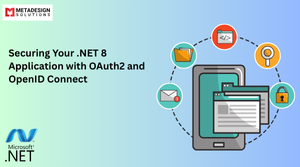Introduction
Security has become an integral part of software development, especially in today’s digital era where cyber threats are constantly evolving. As a developer working with .NET, creating secure applications requires leveraging the right tools and implementing best practices to ensure the safety of data and user interactions.
This blog will guide you through:
- Key security concerns in .NET application development.
- Tools and techniques to safeguard your applications.
- Practical examples of implementing secure coding practices.
- Related services such as cloud security, identity management, and data encryption for businesses.
At MetaDesign Solutions, we specialize in building secure, enterprise-grade .NET applications. Let’s dive in to explore how you can secure your apps effectively.
Key Security Concerns in .NET Development
To build a secure application, it’s essential to understand the common vulnerabilities in software development. Here are the most critical threats:
- Data Breaches: Unprotected data is susceptible to unauthorized access, leading to potential misuse.
- SQL Injection: Attackers exploit vulnerabilities in query inputs to execute arbitrary SQL commands.
- Cross-Site Scripting (XSS): Malicious scripts are injected into web pages to compromise user information.
- Authentication Flaws: Weak authentication systems make applications vulnerable to unauthorized access.
- Session Hijacking: Exploiting session IDs to impersonate a user and gain control over their account.
Understanding these threats is the first step toward developing secure .NET applications.
Tools and Techniques for Secure .NET Applications
ASP.NET Identity
ASP.NET Identity is a robust framework for managing user authentication and authorization. It supports:
- Multi-factor Authentication (MFA).
- Role-Based Access Control (RBAC).
- Integration with external identity providers like Google, Facebook, and Microsoft.
Example: Secure user login with ASP.NET Identity
var user = await _userManager.FindByNameAsync(model.Username);
if (user != null && await _userManager.CheckPasswordAsync(user, model.Password))
{
var token = await _signInManager.CreateUserPrincipalAsync(user);
return Ok(new { Token = token });
}
Azure Key Vault
Azure Key Vault is a cloud service designed to manage secrets, keys, and certificates securely. By using Key Vault, you can store sensitive information such as connection strings and API keys.
Example: Access secrets from Azure Key Vault
var client = new SecretClient(new Uri("https://<YourKeyVault>.vault.azure.net/"), new DefaultAzureCredential());
var secret = client.GetSecret("DatabaseConnectionString");
Console.WriteLine(secret.Value);
Secure Communication with HTTPS/TLS
Always use HTTPS to secure communication between your application and the client. TLS ensures encrypted data transmission, preventing eavesdropping and tampering.
Steps to Enforce HTTPS:
- Configure HTTPS in your launchSettings.json.
- Redirect all HTTP requests to HTTPS using middleware:
app.UseHttpsRedirection();
Secure Development Practices
Use Parameterized Queries
SQL injection is a common vulnerability in web applications. Always use parameterized queries to prevent attackers from injecting malicious SQL commands.
Example:
var query = “SELECT * FROM Users WHERE Username = @username”;
var command = new SqlCommand(query, connection);
command.Parameters.AddWithValue(“@username”, username);
Implement JSON Web Tokens (JWT)
JWT is a compact, secure, and self-contained way of transmitting information between parties as a JSON object. Use it to secure APIs in .NET.
Example:
var tokenHandler = new JwtSecurityTokenHandler();
var tokenDescriptor = new SecurityTokenDescriptor
{
Subject = new ClaimsIdentity(new[] { new Claim("UserID", user.Id.ToString()) }),
Expires = DateTime.UtcNow.AddHours(1),
SigningCredentials = new SigningCredentials(new SymmetricSecurityKey(key), SecurityAlgorithms.HmacSha256Signature)
};
var token = tokenHandler.CreateToken(tokenDescriptor);
Secure Communication with HTTPS/TLS
Always use HTTPS to secure communication between your application and the client. TLS ensures encrypted data transmission, preventing eavesdropping and tampering.
Steps to Enforce HTTPS:
- Configure HTTPS in your launchSettings.json.
- Redirect all HTTP requests to HTTPS using middleware:
app.UseHttpsRedirection();
Fortify Your .NET Applications with Expert Security Practices
Leverage industry-leading tools and techniques to safeguard your applications. Schedule a consultation to discuss how we can enhance your application’s security posture.
Encrypt Sensitive Data
Encryption protects sensitive information such as passwords and personal data. Use libraries like System.Security.Cryptography to implement encryption in .NET.
Example: AES Encryption
using (var aes = Aes.Create())
{
aes.Key = Convert.FromBase64String(encryptionKey);
aes.IV = new byte[16]; // Initialization vector
using (var encryptor = aes.CreateEncryptor(aes.Key, aes.IV))
using (var ms = new MemoryStream())
{
using (var cs = new CryptoStream(ms, encryptor, CryptoStreamMode.Write))
using (var sw = new StreamWriter(cs))
{
sw.Write(dataToEncrypt);
}
return Convert.ToBase64String(ms.ToArray());
}
}
Related Services for Secure Application Development
- Cloud Security Services: Ensure secure deployment and management of cloud resources with services like Azure Security Center.
- Identity and Access Management: Utilize tools like Azure Active Directory to enhance user authentication.
- Penetration Testing: Regularly test your application for vulnerabilities to ensure maximum security.
For businesses seeking reliable security solutions, partnering with a specialized .NET Development Company ensures expert guidance in building secure applications. Contact MetaDesign Solutions to hire .NET developers skilled in security practices.
Best Practices Checklist
- Use secure coding guidelines like OWASP.
- Keep your .NET libraries and dependencies updated.
- Enable logging to monitor suspicious activities.
- Regularly test for vulnerabilities using tools like SonarQube.
Conclusion
Securing your .NET application requires a proactive approach involving tools, techniques, and best practices. From leveraging frameworks like ASP.NET Identity to implementing encryption and secure communication protocols, every measure contributes to building a robust application.
MetaDesign Solutions specializes in secure .NET development for businesses across industries. Reach out to us at sales@metadesignsolutions.com to develop secure, scalable applications tailored to your needs.
Related Hashtags
#SecureApplications #DotNetSecurity #CyberSecurity #AppDevelopment #DataProtection #DotNetDevelopment #Encryption #CloudSecurity #AzureKeyVault #SecureCoding #SoftwareSecurity #DevOpsSecurity #WebAppSecurity #HireDotNetDevelopers #TechForBusinesses



